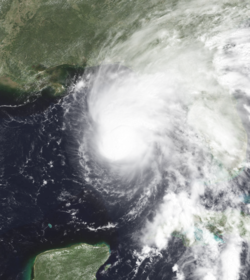| Timeline of the 1995 Atlantic hurricane season | |||||
|---|---|---|---|---|---|
 Season summary map | |||||
| Season boundaries | |||||
| First system formed | June 2, 1995 | ||||
| Last system dissipated | November 1, 1995 | ||||
| Strongest system | |||||
| Name | Opal | ||||
| Maximum winds | 150 mph (240 km/h) (1-minute sustained) | ||||
| Lowest pressure | 916 mbar (hPa; 27.05 inHg) | ||||
| Longest lasting system | |||||
| Name | Felix | ||||
| Duration | 14.75 days | ||||
| |||||
The 1995 Atlantic hurricane season was an event in the annual tropical cyclone season in the north Atlantic Ocean. This Atlantic hurricane season saw a near-record number of named tropical storms. This extremely active season followed four consecutive years in which there was below normal activity. [1] [nb 1] The season officially began on June 1, 1995 and ended on November 30, 1995. These dates, adopted by convention, historically describe the period in each year when most tropical systems form. [3] The season's first system, Hurricane Allison, developed on June 3; its last, Hurricane Tanya, became extratropical on November 2.
Contents
The season produced 21 tropical cyclones, of which 19 intensified into tropical storms, 11 of which became hurricanes, and five became major hurricanes. [4] [nb 2] The four most notable storms during the season were hurricanes Luis, Marilyn, Opal and Roxanne. Luis caused extensive damage in the northern Leeward Islands in excess of $2.5 billion (1995 USD). [4] Marilyn affected the same area a few days later, causing eight deaths and damages in excess of $2 billion in the U.S. Virgin Islands. [6] Opal was a strong hurricane that, after battering the Yucatán Peninsula of Mexico, cross the Gulf of Mexico and made landfall near Pensacola Beach, Florida. There were 27 hurricane-related deaths were reported in the Southeastern United States. [7] Roxanne caused widespread flooding and crop damage throughout much of the Yucatán Peninsula, and killed at least six people, due to its erratic movement. [8] Following the 1995 season, these four storm names were retired from reuse in the North Atlantic by the World Meteorological Organization. [9]
This timeline documents tropical cyclone formations, strengthening, weakening, landfalls, extratropical transitions, and dissipations during the season. It includes information that was not released throughout the season, meaning that data from post-storm reviews by the National Hurricane Center, such as a storm that was not initially warned upon, has been included.
By convention, meteorologists use one time zone when issuing forecasts and making observations: Coordinated Universal Time (UTC), and also use the 24-hour clock (where 00:00 = midnight UTC). [10] In this time line, all information is listed by UTC first with the respective local time included in parentheses.













